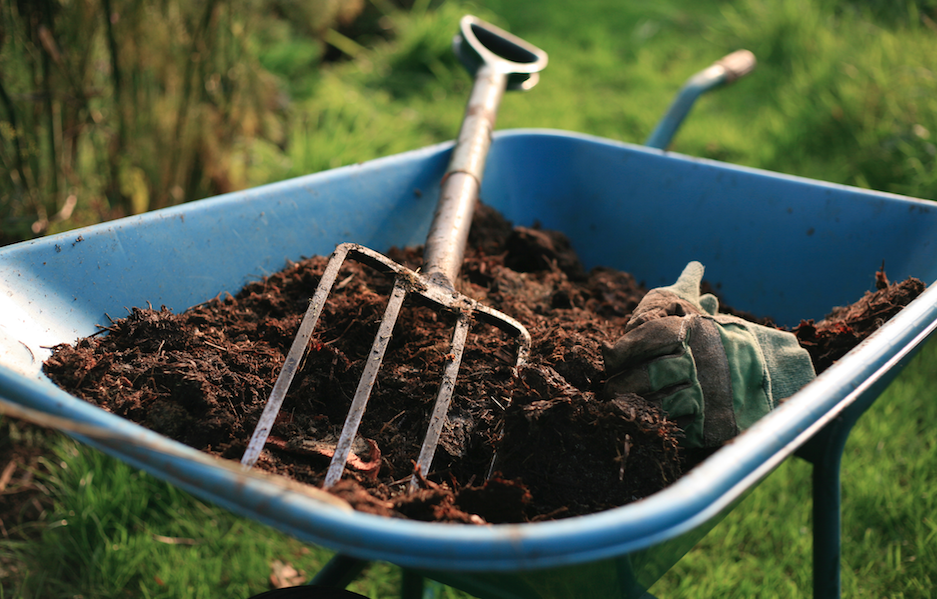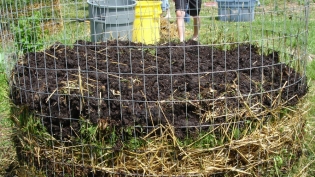The Dirt on Gardening
Whether you call it dirt or soil, a little TLC in a garden bed goes a long way to ensure healthy plants, tasty vegetables and savory herbs for your table.
In summer, the most important thing is to avoid soil compaction. When weeding or harvesting your vegetables, herbs and edible flowers, don’t step in the garden bed. Walking on the soil compacts it, impeding the development of roots and eliminating or reducing critical pockets of air and moisture.
When fertilizing vegetables this summer, consider using an organic product. Synthetic fertilizers feed plants, but do nothing for the soil. Throughout the summer, continue to improve the soil by adding a light layer of compost as mulch around your food plants once or twice. Compost is nature’s gift to the gardener.
Over time, compost helps cure poor-draining clay soil and fast-draining sandy soil. As it breaks down, compost improves the overall quality and texture of the soil, called tilth. It helps the soil retain adequate moisture while improving drainage. And, it feeds the billions of microorganisms in the soil that enable and nourish good root development, which results in healthy plants, making them better able to withstand environmental challenges, such as drought, insects and disease.
If you are new at growing your own food, it’s not too late to get started. You can also prepare a garden bed in fall for spring planting. There are a couple of tracks you can take. Easy is a raised bed made just the right size for you and your family. Digging a new bed in the ground is harder, but frequently a very satisfying way to grow your own.
The Easier Way
For urban foodies, a raised bed is the way to go. That’s because many yards have heavily compacted soil and knotty tree roots, which make digging difficult. Also, inside I-465, there may be concerns about lead contamination of the soil, eliminating root crops, such as potatoes and carrots from the menu. Raised beds also work well in suburban gardens.
Raised beds are the equivalent of instant gardens. Although many raised beds are framed with wood, bricks or other material, they don’t have to be. They can be as simple as a mound of soil. You should be able to reach halfway into the bed from one side, so it’s best not to make it wider than about four feet, eight to 10 inches deep.
The easy part is no digging. Define the raised bed, take the measurements, then call one of the city’s landscape suppliers and order enough planter’s mix to fill or form your raised bed. It’s just that easy.
There are other advantages of a raised bed:
You don’t have to remove the grass. Just plop the raised bed right on top of the turf.
It warms up faster in spring, which means you can plant snow peas, carrots, lettuces and other cool-season crops earlier.
It drains better.
There are few to no weeds in a raised bed.
If ground is not available to you, grow vegetables in containers on the patio, deck, balcony or porch. Or participate in a community garden program.
The Harder Way
This is for the blood, sweat and tears crowd that likes nothing more than getting dirty for a good cause. Whether you use a rototiller, which you can rent, or a spade, you need to dig the new bed at least 12 inches deep, breaking up clumps of soil as you go. Once the bed is dug, add at least three inches of compost, chopped leaves or rotted manure and work that into the freshly dug bed.
A tried-and-true method of bed preparation is double-digging:
Remove grass and weeds from the soil surface.
Dig a trench 12 inches deep and wide. Put the soil from the trench on a tarp or in a wheelbarrow for use later.
Next to the first trench, dig the second, moving the soil into the first. Break up clumps as you dig.
Continue digging trenches as needed to achieve the size bed you want.
Fill the last trench with the soil saved from the first trench.
Apply two or three inches of compost, rotted manure or chopped leaves to the freshly dug bed and work it in. If you do this in fall, do not work in the organic matter. Allow it to break down naturally over the winter.
Whichever method you select, make sure your vegetable garden is in full sun, with at least six hours of direct sunlight. Also, locate it close to a water source. Vegetables need about one inch of water a week to produce well. Be sure to water the soil and not the plant. Overhead watering is wasteful because of evaporation and it can contribute to fungus diseases. Soaker hoses or a drip irrigation system work well.







